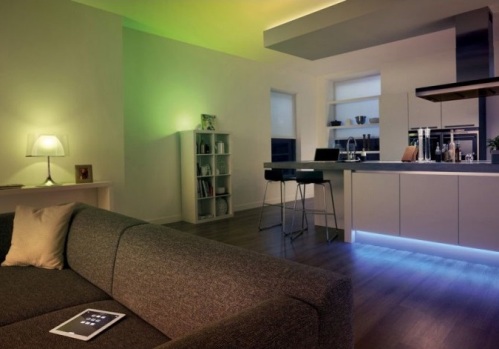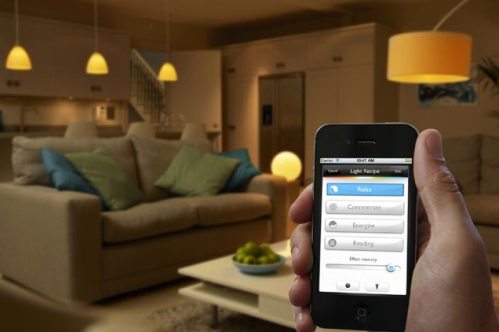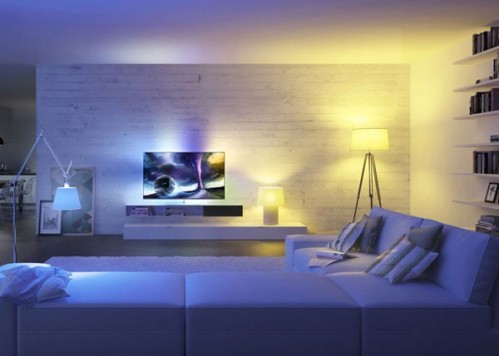Categories: Featured Articles » Home automation
Number of views: 13746
Comments on the article: 3
Smart home lighting scenarios
 For a long time, lighting systems with cotton on were no wonder, for those days had passed when such a technical miracle could be observed only in Hollywood films. Moreover, other lighting scenarios are possible. in smart home, for example, the inclusion of light when the motion sensor is triggered or depending on the degree of natural light. The various scenarios of smart lighting will be discussed in this article.
For a long time, lighting systems with cotton on were no wonder, for those days had passed when such a technical miracle could be observed only in Hollywood films. Moreover, other lighting scenarios are possible. in smart home, for example, the inclusion of light when the motion sensor is triggered or depending on the degree of natural light. The various scenarios of smart lighting will be discussed in this article.
One button to turn off lights throughout the room
If you turn on the light, where necessary, you can, as necessary, then turn it off, you can sometimes easily forget. For example, a man came into the kitchen, made tea, and suddenly remembered a case that he urgently needed to do in another room.
He goes there, continues his activities, at the same time distracted by something else, and in the kitchen the light remained on. Suddenly you need to go somewhere, he urgently puts on his shoes .. And the light throughout the apartment is on!
In this case, the scenario of turning off the light by pressing one button located on the wall in the hallway is very useful.
The development of this solution is remote control using a smartphone or simply from a mobile phone via SMS. He left home, remembered that he had forgotten to turn off the light, and with the help of remote control, he solved the problem with just one command.

Motion Sensor Lighting Control Scenario
A man entered the room - the light turned on. He left the room - the light went out. Lay down with a book - the wall lamp turned on. The night has come - Motion Sensor switches to the night illumination group, and the main light, say a chandelier, does not turn on at night, only a weak night illumination, for example, LED, remains.
The last option is a combination of a script for the sensor and a script for time. It is definitely convenient to customize the script based on individual needs and habits.
Scenario of lighting control depending on the time of day
This scenario is perfect for a bedroom, kitchen or bathroom. The convenience here is that with just one switch at different times of the day, different groups of the lighting system will be switched on.
For example, by pressing the switch button at night in the bedroom or in the kitchen, only the backlight will turn on. If it’s evening, then the main light will be on. If it’s morning in the yard, the table lamp will turn on. Again, you can customize.
This solution is useful for the eyes, because if you immediately turn on the bright light in the dark at night, your eyes will not be comfortable, but if only the backlight turns on, your eyes will perceive it more calmly, with less stress.

Stepless brightness control
This scenario can be a kind of variation of the combination of lighting control over time and the inclusion of a motion sensor. For example, when you turn on the light at night, the brightness of the lamps will gradually increase over 5 minutes, but first the light will be dim. In the morning, during waking hours, for example in the bathroom and in the bedroom, the smooth turning on of the lamps will also be very comfortable.
Such a solution will make it possible to use only one lighting group instead of several, since the same light sources will give light of different intensities.
The duration of a smooth increase in brightness can be adjusted individually. In addition, the lack of natural light can be smoothly compensated for throughout the day: starting from the dim light in the morning, the lamps will gradually go to full brightness by evening.
By the way, for lamps, such a smooth on mode is not only safe, but also useful, since the lamp life will significantly extend in the absence of sharp inrush currents at the moment they are turned on.

Scenario of lighting control by sensor depending on the lighting conditions
It is very convenient to have two lighting groups in the living room or in the kitchen to complete this scenario. For example, at dusk the light sensor will turn on both groups of lamps, and if it is daytime, and besides, the day itself turned out to be sunny, then the light will not turn on at all. On a cloudy day, only one group of lamps will be automatically turned on.
For the kitchen, it is useful to illuminate the workspace in the daytime, and turn on the general light at dusk (this is different from time control, for example, it gets darker in the winter before the window and later in the summer).
Obviously, there is no fiction in smart lighting according to scenarios, since this is just the smart work of modern electronics, which can be installed both in the home and, in principle, in any other room.
In fairness, we note that the scenarios listed here are by no means a complete list of the possibilities of smart lighting, and there are very, very many different scenarios of smart lighting. One way or another, the choice of combinations should be individual.
See also at e.imadeself.com
:
